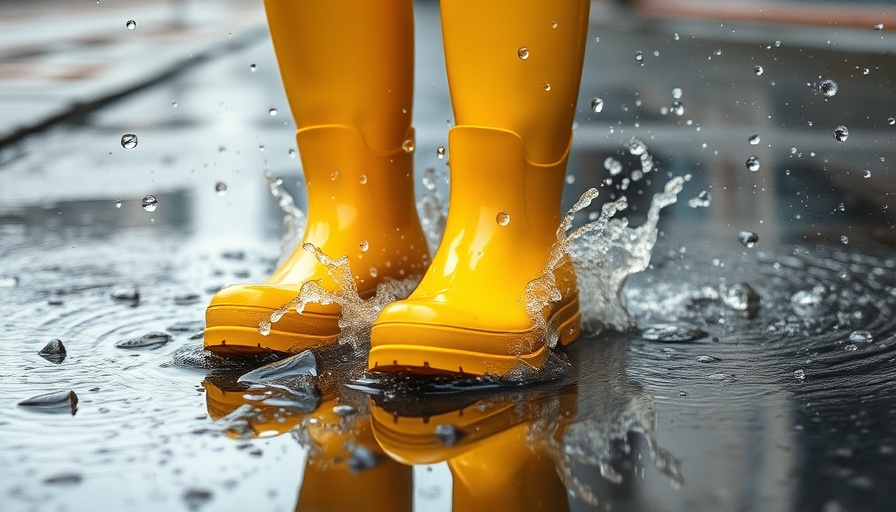
Understanding the Risks: Why the Monsoon Season Matters for Young Athletes
The arrival of the monsoon season is often a welcome reprieve from the sweltering heat, but it also ushers in a myriad of risks for young athletes. With slippery playgrounds and muddy fields, children engaging in sports and outdoor activities face an increased potential for injuries. Falls, sprains, and fractures become more common during this time as wet surfaces diminish traction. According to the latest data, children's injuries peak during the rainy season, highlighting the urgency for education on safe play practices.
Preparing Young Athletes: The Importance of Proper Warm-Up Exercises
One crucial step in preventing sports injuries during the monsoon is ensuring that children engage in proper warm-up exercises before play. Drenched fields can lead to stiff muscles, which are more prone to pulls and strains. Activities such as light jogging, dynamic stretches, and balance drills can significantly reduce injury risk by promoting flexibility. Remember, a proper training routine not only focuses on technique but also prioritizes physical preparation. Parents should encourage their children to spend 10-15 minutes warming up, especially during the cold and wet months.
Choosing the Right Gear: Footwear and Protective Equipment
Investing in appropriate footwear is critical during the rainy season. Anti-skid shoes designed for better grip on wet surfaces can prevent many slips and falls. Additionally, protective gear such as knee pads, helmets, and elbow guards should not be optional; they can be lifesavers in an athletic environment. Even if children are merely running in the neighborhood or playing in the park, the right gear helps safeguard them against unforeseen accidents.
Indoor Alternatives: When to Keep Kids Inside
If conditions are particularly bad, it might be prudent to steer children toward indoor activities. Community centers, gyms, or even simple home-based exercises can provide safe alternatives to outdoor play during dangerous weather. Activities like martial arts not only enhance physical abilities but also build mental resilience and situational awareness—traits that are essential, especially in unpredictable situations.
Emotional Resilience: Supporting Kids Through Injuries
Sports injuries are not just physical; they take an emotional toll. When faced with the frustration of being sidelined, children can experience mood swings and lowered self-esteem. Parents and coaches should provide emotional support by recognizing these feelings and encouraging a positive outlook. Setting achievable recovery goals and reminding children of their strengths can uplift them and help foster a strong mental attitude.
Training Strategies: Incorporating Injury Prevention in Martial Arts
For those practicing martial arts, implementing specific preventative measures is key to injury avoidance. Drills focused on flexibility and conditioning can dramatically decrease injury rates. Integrating martial arts injury mitigation techniques into training routines reinforces the importance of safety. Simple techniques, such as body mechanics training and practicing recovery moves, help instill safe habits in young martial artists.
Essential Safety Guidelines: Actionable Steps for Parents
Encouraging children to prioritize their safety during the rainy season involves more than just making them aware of risks. Here are some actionable steps parents can take:
- Ensure your child understands the importance of warm-up exercises before engaging in sports activities.
- Invest in proper footwear with good grip and protective gear relevant to the sport.
- Create a contingency plan for transitioning to indoor activities when weather conditions worsen.
- Encourage open communication about any fears or worries your child may have regarding injuries.
- Model emotional resilience yourselves; your attitude can influence how they cope with setbacks.
Conclusion: Take Action Now to Ensure a Safe Play Environment
As the monsoon season approaches, it’s vital to equip our young athletes with the knowledge and tools they need to stay safe. By emphasizing the importance of injury prevention, proper warm-up routines, and choosing the right gear, we can protect our children from unnecessary injuries. Let’s work together to foster a culture of safety that ensures outdoor play remains fun and risk-free. For more guidance, explore preventative fitness routines tailored to children and get involved in injury prevention workshops. The health and safety of our future athletes depend on proactive measures today!
 Add Row
Add Row  Add
Add 




Write A Comment